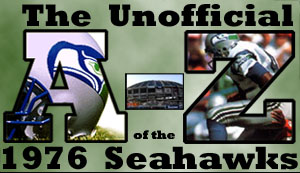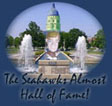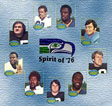
No longer a child, not yet middle-aged, and still finding their place in the NFL world.
...the 30-year wall of silence is an impressive achievement for a League that leaks as a lifestyle.
He recommended Jack Patera enthusiastically for the Seahawks...
The letter C is coming soon!
The Seahawks used Williams’ local reputation as a promotional tool, as they would do (very briefly) with Ahmad Rashad.
The average Seahawk selected in the veteran allocation is 6-2, 222 pounds, just under 26 years old and is entering his fourth NFL season.
The Seahawks played the Rams...facing off against future Seahawk coaches Chuck Knox, Tom Catlin and Ken Meyer.
...management decided early to pursue coaches with no NFL head coaching experience.
Patera had the boldness to recruit 3 coaches with no NFL service...
...why was there no place for one of the ultimate local heroes of the early 1970s – Sonny Sixkiller?
Thompson may have looked on paper like a conservative and safe manager for a new team with first-time owners, but...
...reports from the camp are unclear as to who did the special team evaluations.
As a defensive coach, Jack Patera valued his linebackers.
Maybe we'll come up with something soon!
...nobody else on the Seahawks squad took their dislike quite to the extent of Ahmad Rashad.
The Nordstroms were an obvious possibility because of their wealth and local presence.
Approximately 14 members of that squad would never play for the Seahawks again.
A simple lesson in draft history is to list the fate of quarterbacks for several years before 1976.
Jack Patera was unable to take a single Redskin veteran from the allocation list.
...the Seahawks’ offense would be directed by 3 men who had 2 years of NFL experience between them
Terry Brown’s Seahawk career lasted less than 24 hours.
...we think this story might just have been a good Patera Prank!
While Patera had an inside edge on stocking his team with Vikings, he only chose one Viking from the allocation...
Character would clearly play a part...
Patera lived up to his code of we will tolerate you until we can replace you...
Yes! We will have something for Y eventually!
What more need we say?
|
Intro |
A |
B |
C |
D |
E |
F |
G |
H |
I |
J |
K |
L |
M |
N |
O |
P |
Q |
R |
S |
T |
U |
V |
W |
X |
Y |
Z |
Home

V is for Vikings
Jack Patera was given 2 lifelines back to his old (and very successful) club. The veteran allocation gave him up to 3 recruits from the Vikings, while the Seahawks had first access to any player released from an NFC team after 1 July 1976. The expansion teams were required to consult with each other on each delisted player they wanted, to make sure that the team with the preferential choice could exercise it if it wanted; so if Patera wanted Vikings he was well placed in theory to move.
While Patera had an inside edge on stocking his team with Vikings, he only chose one Viking from the allocation — a wide receiver. The Seahawks would have no complaint about the choice of Sam McCullum, but Patera left 2 more Viking choices on the table. So why did he take so few Vikings in total, and later take only one (backup) member of his old line (Bob Lurtsema)? The Vikings had the same dilemma as other elite teams: their right to protect 32 players would leave a number of other quality players in the depth chart open to allocation. The NFL had reduced the problem by allowing teams to remove 2 players from the allocation list for every player picked; but the Vikings still went into the allocation with more good players than protected positions. A conspiracy theory would suggest that Patera had decided (or agreed) to go easy on his old team but this isn’t backed up by the Buccaneers, who had no similar motivation. John McKay raided the Vikings for a cornerback (Joe Blahak) and a guard/center (John Ward), who would both move to new teams within the first month of the regular season: but like Patera, he couldn’t find any other reasonable prospects on offer from the Vikings’ renowned offensive and defensive lines. Bud Grant retained 32 members of his 1975 squad in 1976. Apart from linebacker Bob Stein (who had only been brought in for 9 games at the end of a 7 year career) every defensive lineman and linebacker returned for 1976. In addition to Stein, Grant would turn over 3 defensive backs, a quarterback, 4 receivers, 3 guards and 2 running backs. Allowing for retirements and loss of form, this is still a large number of potential recruits from a highly successful team. But apparently, still not good enough for the Seahawks and Buccaneers.
|


